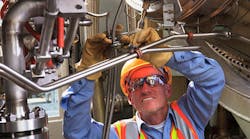Jim responds to a trouble call, and:
- The operator isn't there to describe the problem.
- Parts are still on the machine and he must move them to run diagnostics.
- Boxes are blocking the branch circuit panel.
- A test point requires Jim to climb a ladder, so he spends 20 minutes finding one.
- Jim identifies a bad module and a blown fuse.
- Jim visits the stockroom for replacement parts. The first module has corrosion, so he has the attendant get another.
- Jim returns from the stockroom to find his ladder has been taken. But he needs it to install the fuse.
- After fifteen minutes, Jim returns with the ladder. Before installing the fuse, he tests it with his DMM. The fuse is blown.
- Jim returns from the stockroom with a fuse he tested there before leaving. His ladder is gone.
- Jim returns with a ladder, a chain, and a padlock. This took him “only” half an hour.
These kinds of system problems, if not addressed, will dog future repairs. Repair techs encounter system problems all the time. Do you have a means for them to report these and for maintenance to take corrective action?




